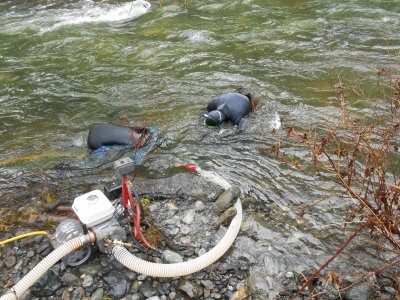
Early March is a heck of a time to do underwater mining. The water is cold, and on this particular day, the creek was running higher and faster than normal because of a rain storm just a few days before.
I wanted to experiment with this new method of underwater blow mining in California before the warmer weather gets started. So I decided to visit Happy Camp to try it out on the New 49er South Fork of Indian Creek property. This is a place which is well known for producing nice gold nuggets. I once recovered quite a large gold nugget using a metal detector along the bank of the stream on this property. Bedrock is very close to the surface in most places. So you don’t have to work that hard to get down to the cracks where gold can be found. I was doing quite well there using a suction dredge several years ago.
Before going down, I lined up Steve Jones and John Rose to come on out and join me for an adventure. Those guys are always ready to go! Several other New 49’er members also came along. Since I have the most experience doing underwater video, Steve jumped right in there with the nozzle and did a lot of the mining work. This is Steve’s second winter supporting himself from the gold that he mines along the Klamath River. He’s a hardy guy!
Using the blow mining method is the same thing as using a blaster nozzle on a suction dredge to cut through and break up hard-packed layers and bedrock that a dredge nozzle won’t take apart. But in this case, we were mainly using the blow nozzle to help move material out of the way and help us get down to the bedrock cracks faster. Really, this is just a step further than raking and fanning material out of the way with your hands.
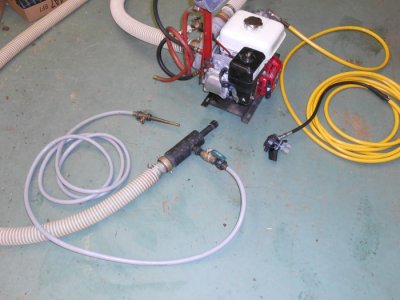
Steve and John suggested we could take the process one step further and blow the material into a second blowing device with a hopper that can be used to direct material through a hose to a sluice box (see next section below). But since South Fork mostly has bigger gold, we decided to just use the primary blower nozzle to see what we might find by uncovering some cracks on the edge of the creek.
We were using a 6.5 HP motor, mostly running on idle, with a standard mining pump and hookah compressor to supply underwater breathing air. You could also use a normal trash pump for underwater blow mining in shallow water. It’s pretty easy to adapt some ABS or PVC fittings to a pressure hose coming off the pump. Any motor that otherwise might be used to power a dredge or high-banker can be easily adapted to this kind of mining. My own dredge uses a Keene 1-inch high pressure hose going to a blaster nozzle tip. That provides plenty of power to push material around underwater!
John captured this video afterwards, while we explained what we were doing:
The gravel and overburden on the edge of the creek was only about a foot thick when we started. Sometimes it takes more effort to strap on divers weights when working in shallow water. We decided to tough it out without them. John explained what we were doing in the following video sequences:
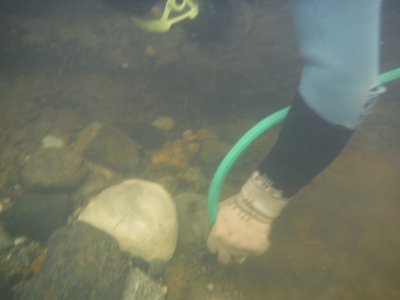
A larger 1 ½-inch blaster hose and nozzle was connected to the pump which certainly would have moved the overburden off faster. But since that would have made the underwater filming more difficult to capture, and there was only about a foot of material to move out of the way, we decided to just use a garden hose without the blaster nozzle tip at first to help move most of the top material off. Once we got down to bedrock, we attached the narrower-tipped blaster nozzle to help take apart decomposed bedrock. We were hoping to find some gold underneath. Here is some of the underwater action:
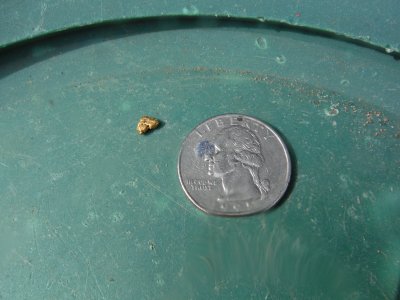
We were all pleasantly surprised to discover that it is quite easy using this method of underwater blowing to gain access to shallow gold deposits. By this, I mean shallow material. You can use this method in deeper water with the use of hookah gear. I’m looking forward to using this method along the banks of the extensive new mining properties The New 49’ers have acquired downstream of Happy Camp during the past few months. I’m sure those areas have not been mined during the modern age!
Shortly after reaching bedrock, we found a beautiful Indian Creek nugget stuck in a crack in the bedrock. I’m pretty sure I saw the nugget first because I was upstream with the camera from the slight cloud Steve was stirring up with the nozzle. For just a moment, I thought Steve was going to blow the nugget away! But, of course, gold is too heavy for that. Fortunately, I had the video camera on at the moment of discovery:
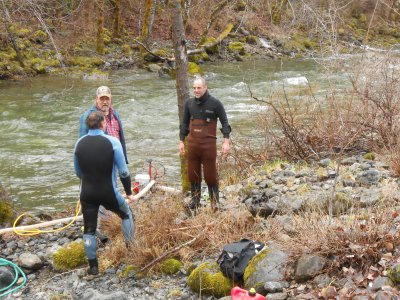
We wanted to do more prospecting; but after getting out of the water to congratulate ourselves, we found ourselves shivering up on the bank. We had such a great time exploring this new method of mining, we finally decided to call it a day and start making plans for the next time.
There seem to be more New 49’er members around Happy Camp this year than during prior winters that I have spent down there. It’s always a great time visiting with other members! Maybe next time I will use a wet-suit heater so I can devote more time recovering those easy nuggets. Or better yet, spring is only about a month away!
Taking Blow Mining to the Next Level!
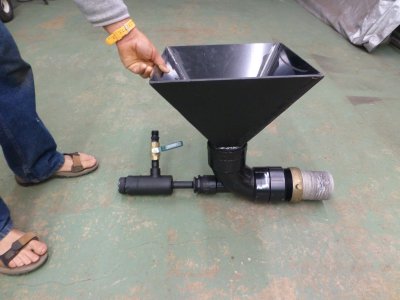
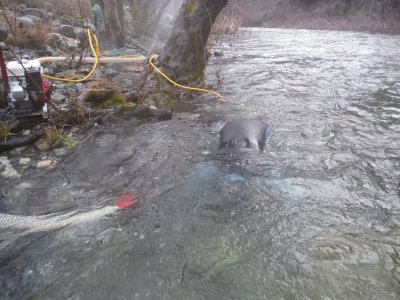
Last season, when the State of California decided to redefine “suction dredging” as “…the use of a suction system to vacuum material from a river, stream or lake for the extraction of minerals,” we immediately went to work on creating a new system which relies completely on water blowing to move streambed material to a hopper either above or below the water, and then through a hose to either a container or recovery system.
While the new system relies upon the same types of engines, pumps and underwater breathing systems we have historically used in most of our small scale mining activities, there is no suction or vacuum employed to excavate material off the bottom of the waterway. We only use blowing, thus the new term “blow mining.”
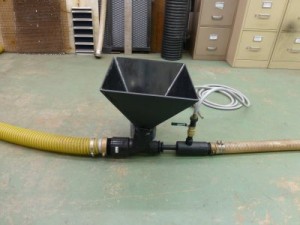
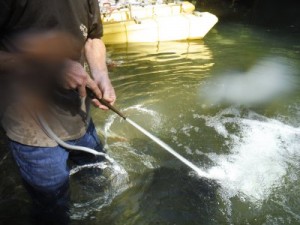
To my knowledge, you cannot buy these blow mining hoppers as ready-made devices. But they are not hard to fabricate at home. We glued our prototypes together with ABS plastic materials. We reduced the jetting down to ¾-inch tubing from the traditional 1 ½-inch pressure hose that extends from a 6.5 HP motor and pump. As you can see from the images, we added in a garden hose and valve so we can blow material into the hopper. You can also feed material into the hopper by hand. Through testing, we found that a 6.5 HP Honda will supply enough power to deliver material to either a 3-inch or 4-inch recovery system (sluice box) that can float on pontoons out on the waterway.
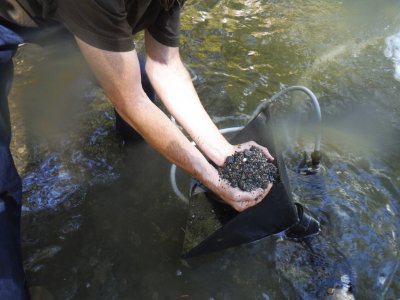
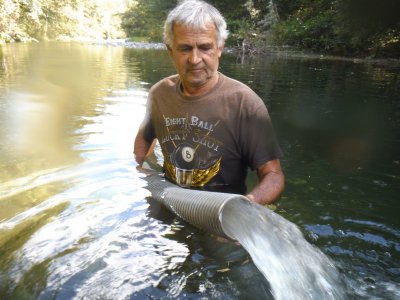
Several of our members began using these blow mining techniques late last season when the wardens started coming around to inform miners that the definition of suction dredging had been expanded to include any type of suction or vacuum mining on the bottom of the waterway. When the wardens were informed that these prospectors were only using blowing techniques to move stream-bottom materials, the wardens went away and that was the end of it.
We will leave one of the prototypes at the office so everyone can get a look at it. When constructing your own, I caution you to be mindful that no suction or vacuum can be used to excavate material off the bottom of the waterway. This is largely a matter of placing the pressure jet so that it blows material through a delivery hose. It is also a matter of creating a feed hopper which is large enough that it will catch materials directed its way without creating even a fraction of suction strong enough to perform excavation on its own. Some of our members are calling this an “underwater high-banker,” though I point out that the very same system is also effective above the water.
Here are some very helpful video sequences to demonstrate the system:





